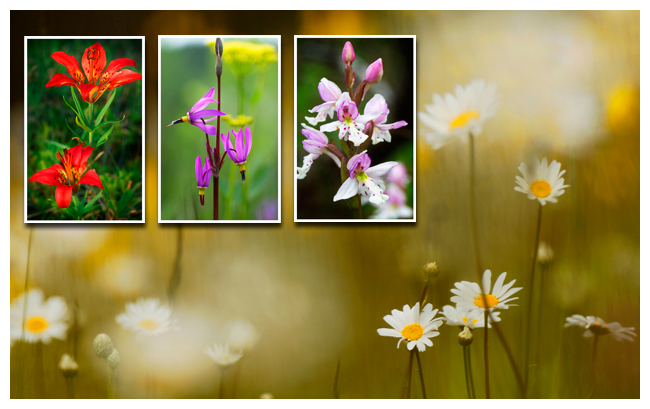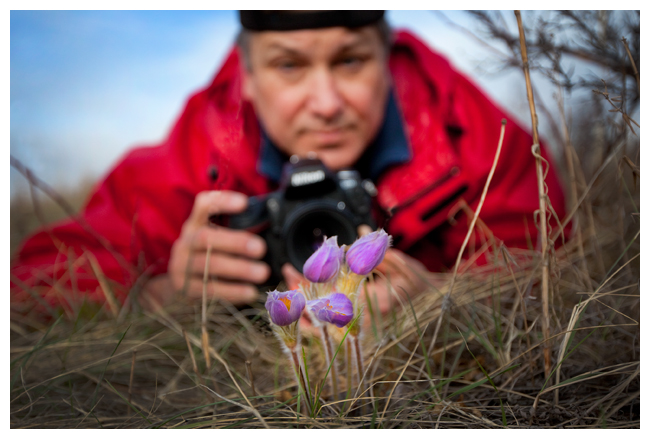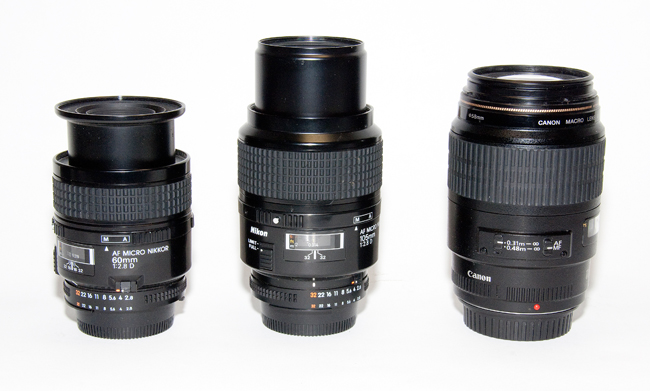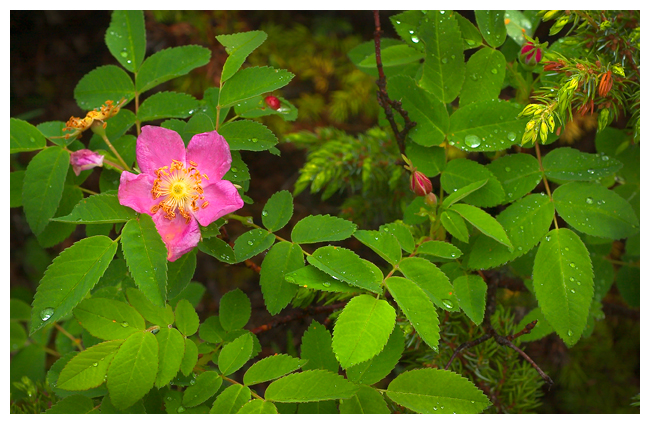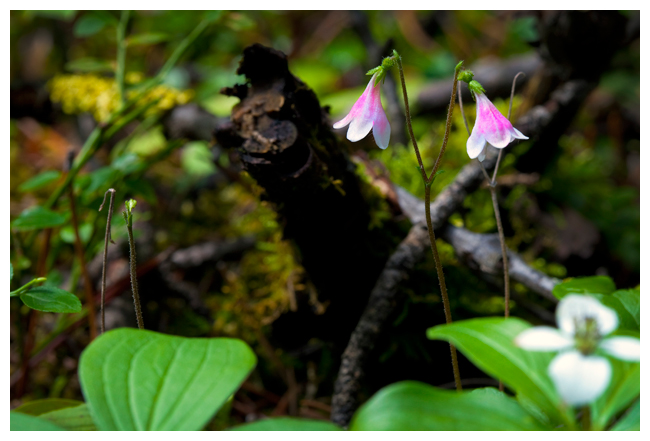
Photographing Wildflowers in the Canadian Rockiesby Robert Berdan © Download slide show on Macrophotography PDF
Wood Lily, Shooting Star, Round Leafed Orchid and Oxeye Daisy's
Glacier Lily (Erythronium grandiflorum) meadow along Elbow river near Elbow lake with Mt. Rae in the background. There are more then 900 species of wildflowers in the Canadian Rockies yet the average person who visits the mountains sees only a few. Many of the flowering plants emerge at specific times and may only last for a few days or weeks at most. One of the first flowers to appear in the Canadian Rockies is the prairie crocus which can appear as early as March in the valleys. These hardy plants can survive even after being covered with snow. One reason for this is that the Prairie crocus and certain other Alpine plants generate heat using an exothermic chemical reaction that melts the snow around them. The glacier lily is another common plant that occurs early in the season and seems to follow the retreat of the snowline. As the ground begins to warm up we begin to see a succession of different flowering plants. One advantage of living near the mountains is that we can observe a variety of wildflowers throughout the Spring and Summer by climbing to different altitudes. Some plants may not even begin to flower until late July or August in the mountains.
Robert Berdan photographing a bunch of prairie crocuss flowers photo by Donna Berdan As a photographer I enjoy searching for and photographing different species of wildflowers. Wildflowers also make good subjects for beginning photographers because unlike wildlife, once you find them, they won't run away. In fact the biggest challenge is finding them and getting them to hold still in the wind. Most of the new digital compact cameras offer a macro mode that will allow photographers to move in very close. The trick is to focus carefully and hold your camera still while you take the shot. Cameras with a live preview on the liquid crystal display can be very helpful for this. If your camera can focus manually you may also find this feature helpful. Photo-enthusiasts that own cameras with interchangeable lenses may want to invest in some additional accessories or special lenses to get very close. Some of these accessories include: close-up filters, extension tubes, tele-converters or macro lenses. A tripod is also important because as you move in close to a flower your depth of field will become very shallow and it becomes more difficult to focus accurately. If you do purchase a tripod for wildflower photography select one that allows the legs to go flat to the ground so you can get closer to your subject.
Nikon 60 macro, Nikon 105 mm macro and Canon 100 mm macro lens
Prickly Rose (Rosa acicularis) is the floral emblem of Alberta and blooms throughout the summer. The best light for photographing wildflowers occurs on overcast cloudy days. Sunny days tend to create too much contrast and over exposed highlights. A flash can be helpful if you are hand holding your camera, but generally I prefer to use natural light when ever possible. My favourite time to shoot is right after a fresh rainfall when the plants are covered in water drops and everything looks and smells fresh. A polarizing filter will remove some of the shine and reflections off the leaves and increase the overall colour saturation. I also recommend bringing a good wildflower guide with you when you hike. One I can recommend is "Wildflowers of the Rocky Mountains" by G.W. Scotter and H. Flygare that helps you identify the flowers by their colour. Finding specific wildflowers requires knowledge about when they bloom and what habitats you are most likely to find them. River valleys and damp areas are usually rich in a broad range of wildflowers in early June.
Closeup filters permit your camera lens to focus closer and are relatively economical Taking artistic photos of wildflowers can be a challenge. Most wildflower guide books take pictures of the entire plant including the leaves and stem to facilitate their identification and most of these photos are not suitable to hang on your wall as art. To take more interesting photos you will need to play and experiment with the composition. One thing you can try is photographing through other plants or flowers to create a soft vignette effect around the edges of your photographs. To do this simply have other plants or flowers touch the front of your lens and shoot through them to create out of focus blurs. Another tip is to get in real close and fill the frame with the flower to show off the inner parts of the flower. If the flowers are not covered in natural dew you can add water drops using a small spray or perfume bottle filled with water. Also use your depth of field preview button if your camera has one to check for distracting elements in the background like bright branches or blades of grass. If you find distracting elements move your camera position or try to move the distracting elements. I also take a few notes about the location and time of year I encounter specific flowers so I might return to photograph them another year. Most wildflowers are found low to the ground so you may want to bring a small cushion or use spongy kneepads. Finally, if you find yourself lying in the grass a fair bit to take photos of flowers, check your hair and clothing at the end of the day for deer ticks - they usually won't bite you until you go to sleep, but you don't want to discover one of them embedded in your skin in the morning. Don't ask how I know this.
Limber Honeysuckle (Lonicera dioica)
Prairie crocus (Pulsatilla patens ssp. multifada) emerging after a fresh snow fall. These plants are able to melt snow around them using an exothermic chemical reaction that creates heat.
Twinflower (Linnaea borealis) is common in coniferous forests sending its runners over the forest floor, lichens, moss,
Fairy slipper or Calypso orchid (Calypso bulbosa) are found late May and early June in moist shaded regions often near water. These flowers are less then 10 cm tall. Interested in Learning more about macrophotography and photographing wildflowers see our workshop section Watch Movie on Wildflower Photography Workshop [ Top ] |
